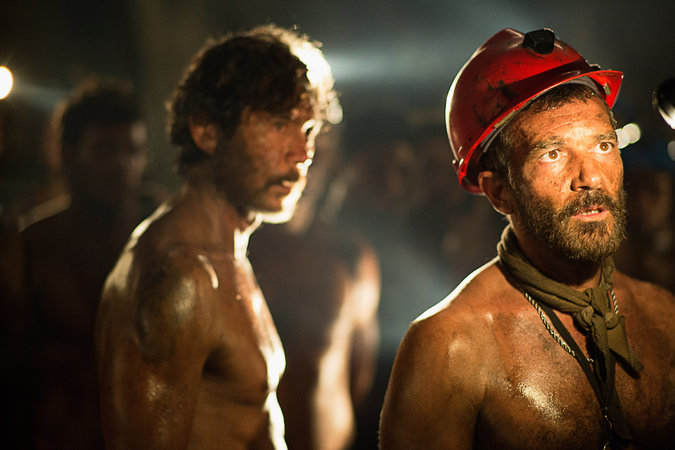The 33: Movie Review
By Olivia Jablonski, Live Wire Managing Editor
If you enjoy the feeling of being trapped, maybe you’ll enjoy “The 33.” The unavoidable consequence of making a movie in which the main characters are confined to a small, dark space for much of the film is that there’s little forward movement. It’s a narrative dependent on absence: the absence of sunlight, conversation, and action.

Lou Diamond Phillips and Antonio Banderas in “The 33.” Photo by New York Times
Despite the absence of those elements though, the movie was released Friday, November 13 and is based on a true story and the story itself is a good one. In 2010, 33 miners were essentially buried in Chile’s 121-year-old San Jose mine notorious for its long history of safety violations. The men were trapped in an unstable mountain 2,300 feet underground, in 90-degree heat, with enough food and water to last just three days. Against almost all logic, every man survived for 69 days, while the entire world watched.
“The 33,” directed by Patricia Riggen from a screenplay by Mikko Alanne, Craig Borten and Michael Thomas, effectively stirs up the emotions we had all over again when we first heard of the incident, and successfully added some new ones inspired by the lives of the miners and the challenge of bringing them out alive.
In a way, even though the movie is moving and suspenseful when you know what the outcome will be, the material is trustworthy. Riggen, a Mexican-born filmmaker whose earlier features include “La Misma Luna” and “Girl in Progress,” has struggled with some daunting challenges, including the familiarity of the story.
She also faced something of a numbers problem: 33 potential protagonists — as well as wives, sisters, children, government officials and engineers — is an awful lot to keep track of. To make matters trickier, most of those characters spend an awful lot of time confined in a small, stubbornly uncinematic space, not doing anything very dramatic.
But with the help of some solid performances and composer, James Horner’s heart-squeezing, throat-constricting score (one of the last he composed before his death in June), “The 33” holds your attention and pushes the required buttons. It starts above ground, at an outdoor party where miners eat, drink, dance, impersonate Elvis Presley and engage in some necessary preliminary exposition. By the time they pile into the bus for work the next morning, we are acquainted with the most important figures. Once the earth shifts and a giant rock seals them into a refuge hundreds of feet down, we know the function each one will play.
The former leader is Don Lucho, played by Lou Diamond Phillips, the captain of the shift, but the actual leader is Mario, played by Antonio Banderas, a charismatic and persuasive guy who rations food, rallies morale and refuses to give up hope when things look bad.
The other miners supply comic relief and dramatic interest. Darío, played by Juan Pablo Raba is an alcoholic, comforted in his worst moments by José played by Marco Treviño, a devout Christian. One man is about to become a father for the first time. Another is a few weeks from retirement. The Elvis impersonator played by Jacob Vargas teases the only Bolivian, played by Tenoch Huerta, in the group. Everyone teases Yonni, played by Oscar Nuñez because of his complicated love life.
The film gains some clarity at the end, and delivers a strong and timely moral message. “God was with us” the miners write on the wall of their refuge as they prepare to return to the sunlight, and at several points the movie emphasizes the importance of religion in their lives.
This seems like a faith-inflected movie for the age of a Latin American populist pope, a parable of spiritual endurance with an eye on social and economic wickedness. Before the credits roll, we learn that the miners were never compensated for their suffering, and that the mining company was cleared of any negligence, a judgment the film emphatically challenges. We also learn that the 33, whose real-life faces fill the screen at the very end, “remain brothers to this day.”


